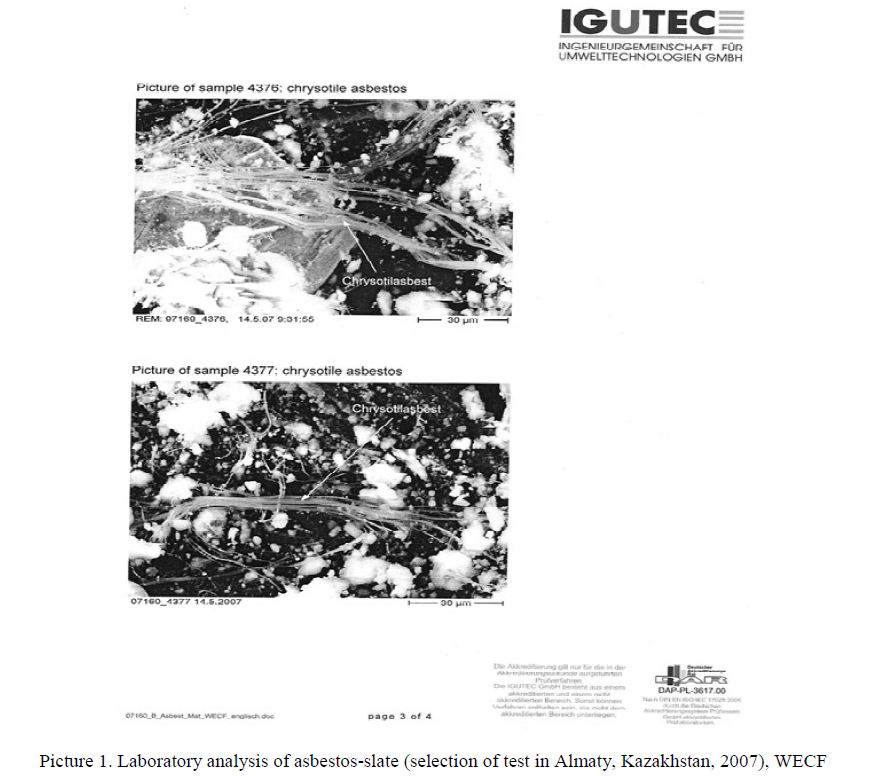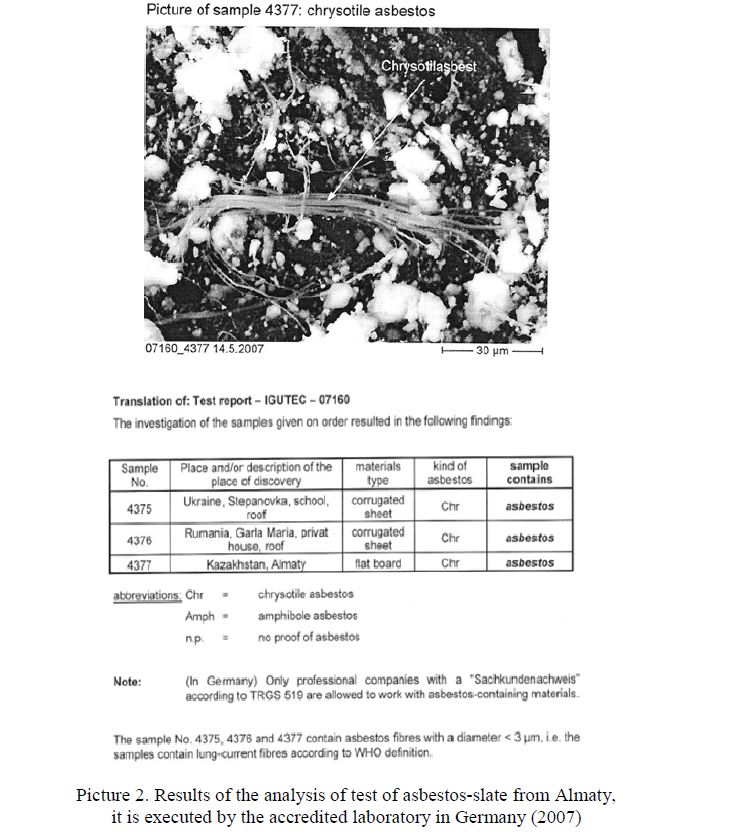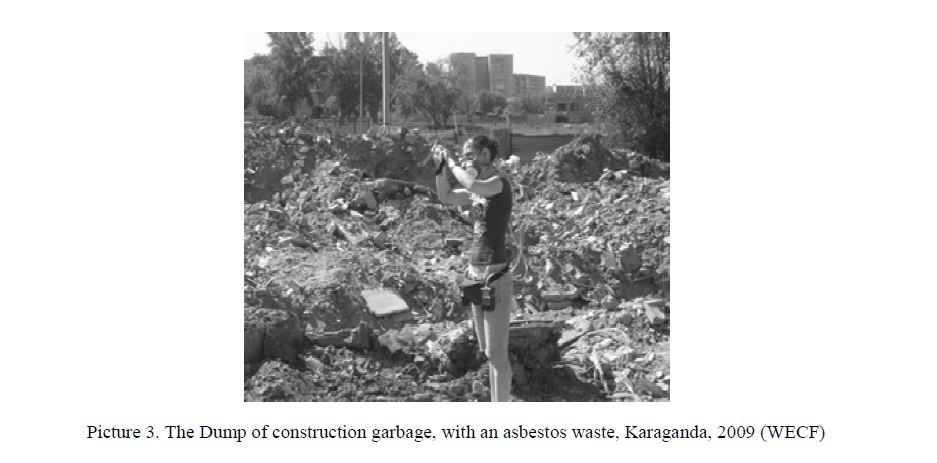The article presented the state of production and use of asbestos in Kazakhstan and the EECCA region. Discussion on potential health risks of asbestos production and use, including NGO recommendation for action. According the WECF \EcoForum partnership project «Civil Society and Sound Hazardous Waste Management in Kazakhstan» and High-Level Conference «Asbestos and POPs — policies and practices in Kazakhstan and the European Union» was identify next steps and recommendations to develop a strategy on asbestos in Kazakhstan and Kazakhstan’s position regarding Rotterdam Convention.
The urgency of a subject of asbestos is caused by that the region of Eastern Europe, the Caucasus and Central Asia — one of the main producers of asbestos in the world. In spite of the fact that production and use of this material are around the world reduced (by it statistical information on growth of malignant diseases affected), the region continues to be in the lead on volumes of production and use of asbestos. In Kazakhstan about 220 thousand tons of high-quality asbestos that there correspond 10 % of annual world production are annually made, thus operational stocks chrysotile are estimated more than in 100 years. In the country asbestsos materials are used without restriction more than 40 years, the enterprises of branch are cityforming that points to social and economic value of chrysotile processing industry.
The law of the Republic of Kazakhstan from March 20, 2007 of No. 239 ratified the Rotterdam convention on procedure of a prior reasonable consent concerning separate dangerous chemicals and pesticides in international trade. Within this convention, the participating country should observe and apply the international instruments of regulation of international trade in separate dangerous substances, instruments of monitoring and control by risks when using dangerous chemicals, including asbestos.
Generally the countries apply various approaches in policy on regulation of use of various forms of asbestos — from controllable use to a ban. Thus the international dialogue concerning safety for human health of chrysotile asbestos and expediency of its introduction into the list of the substances which are subject to consideration Rotterdam convention. However, for the manufacturing countries where production of chrysotile asbestos is recognized by economically expedient branch, such discussions are considered as the international platform for position upholding on prevention of potential threat of a ban of use of chrysotile asbestos and asbestos containing materials. At the last Meetings of the Parties of the Rotterdam convention (in 2008 and 2011) the inclusion question in the Appendix of the Convention ofchrysotile asbestos where participants of meeting didn't come to a consensus on the matter was considered.
With a view of development of a position of the Republic of Kazakhstan concerning production and use of chrysotile asbestos, the meeting at the Prime minister of RK K.Masimov where the decision on need rigidly was made on December 24, 2008 took place to supervise use of chrysotile asbestos and products on its basis; to carry out a package of measures on observance of protection, safety and occupational health concerning the persons working at the enterprises of chrysotile asbestos production, and protection of environment. The assignment to the ministries of environmental protection was given, health care, foreign affairs, the industry and trade to work an advance question in the Secretariat of the Rotterdam convention and position on development of production and chrysotile asbestos use under condition of controllable and responsible use of asbestos [1].
In 2009 the joint project «Civil society and rational regulation of a dangerous waste in the Republic of Kazakhstan» the international network «Women in Europe for a Common Future (WECF), University of Kassel (Germany), Ecoforum NGO of Kazakhstan, Agency of ecological news of «Greenwomen» was realized with financial support of the European Union and assistance of the Ministry of Еnvironmental Protection of the Republic of Kazakhstan. Within the project regional seminars with participation of the European experts and the International conference of experts «Asbestos policy and practice in Kazakhstan and the European Union countries». In work of conference took part Norber Zhusten — the Chief representative of the European Commission, Ivan Ivanov — World Health Organization (WHO), Doctor Donald Cooper — the Executive Secretary of the Stockholm convention, Alexander Mangviro — the Secretariat of the Rotterdam convention, Alen Kuanon — the Ambassador of France, Klaas Van Rubbed Tempel — the Ambassador of the Kingdom of the Netherlands, François Legran — the Ministry of Ecology, the Power, a Sustainable Development and City planning of France, Alexander Niyes — the Ministry of Environmental Protection of Germany and government representatives of Kazakhstan (the Environmental Protection and Health Care ministries and their divisions), Chrysotile association, non-governmental organizations, scientists and experts.
At conference the ecological organizations and experts expressed concern in that in Kazakhstan special epidemiological researches and researches on the occupational diseases connected with asbestos weren't carried out. In the country not enough independent scientific and medical data to have accurate, objective justification for the conclusion about safety of chrysotile asbestos for health of the person. Existing medical researchers in protection of chrysotile-asbestos are guided by such characteristics as a half-cycle of cleaning of lungs from fibers chrysotile, however experts consider that the period of removal from an organism of fibers of different types of asbestos, can't serve as justification for its safety as short, but constant doses aren't less hazardous to health of the person [2]. It should be noted that according to the International Agency of Studying of a Cancer and World Health Organization, asbestos is recognized as one of cancerogenic substances. Because of the proved carcinogenicity for the person production and use of chrysotile-asbestos is forbidden already in more than in 40 countries [3].
Below, in the Picture 1, 2, we give results of the independent laboratory analysis of test of asbestosslate from Almaty, Kazakhstan which was executed within implementation of the research WECF project in 2007. Results of the analysis of test showed that the Kazakhstan asbestos is the same asbestos which is forbidden in 40 countries.

Picture 1. Laboratory analysis of asbestos-slate (selection of test in Almaty, Kazakhstan, 2007), WECF

Picture 2. Results of the analysis of test of asbestos-slate from Almaty, it is executed by the accredited laboratory in Germany (2007)

Picture 3. The Dump of construction garbage, with an asbestos waste, Karaganda, 2009 (WECF)
Results of regional seminars about asbestos showed that a serious problem in Kazakhstan is low level of awareness of the population on potential risks for health from chrysotile asbestos, the waste management questions, containing asbestos aren't solved. Generally it is obsolete construction materials which aren't considered as a dangerous waste. As a result, together with household, an asbestos waste arrives on dumps where continue to poison environment and to harm human health [4].
In the circumstances, when the country is carrying out the independent scientific and medico-biological researches which are based on an assessment of risks is required, and standard requirements and regulation measures chrysotile asbestos aren't developed for ensuring controllable and responsible use, the public considers expedient taking measures to control of use of chrysotile asbestos on the basis of the international ecological principles: Principle «right to know»: the population, workers and experts in the sphere of maintenance, the inspector, workers, the inhabitants of territories testing on influence of the enterprises of the asbestine industry, should know about potential danger of asbestos and diseases which it causes. They should know also about volumes of emissions of asbestos the enterprises, about concentration of asbestos in air round the asbestine enterprises and is direct on a workplace. Such information should be in a free access, actively extend the enterprises, medical institutions, the state supervisory authorities [5]. The granted right is fixed in the Constitution of RK, Arhus Convention, national environmental law of Kazakhstan, EIA procedure, the Law of the electronic Government.
Precaution principle: even if existing data on danger of chrysotile asbestos for health of the person, according to experts are insufficient to declare chrysotile asbestos dangerous, data of WHO should be considered as fundamental for decision-making and measures for decrease in risk of influence of asbestos on human health.
Replacement principle: at possibility of adequate replacement more active to reorient production on use of the safe substances alternative to asbestos.
In Parma, on March 10–12, 2010 at the 5th Conference of ministers on environment and health protection the declaration approved by 53 member states was accepted. Among regional priority tasks it was designated that« … by 2015 we will develop in cooperation with WHO and the ILO national programs connected with asbestos». Thus, within execution of the obligation of the countries under Rotterdam and Stockholm conventions, and also the Parma declaration in Kazakhstan should provide:
Wide access of the Kazakhstan public to reliable information about potential cancerogenic risks of chrysotile asbestos (independent researches and estimates with participation by the Kazakhstan and international experts, public hearings, public examination and population informing).
To develop measures for decrease pollution by chrysotile asbestos in Kazakhstan which includes its inventory and measures for prevention of use of asbestos while building new socially significant objects (kindergartens, schools, high-schools, medical institutions, places of public catering etc.), measures for the consumption waste management, containing asbestos.
By 2015, develop the National plan on decrease in existing and potential negative impact of chrysotile asbestos on health and environment in Kazakhstan in coordination with World Health Organization and the ILO.
Below the final document which was coordinated and accepted at the International conference of experts of the highest level «Asbestos and POPs — Policy and Practice in Kazakhstan and the European union», on April 20–21 2009, Astana, Kazakhstan is provided.
Resolution
of the High Level International Expert Conference «Asbestos and POPs — Policies and Practices in Kazakhstan and the European Union» 20–21 April 2009, Astana, Kazakhstan
Introduction
Part. 1: Asbestos
Asbestos is a sensitive issue in Kazakhstan. Some 220.000 metric tons are produced every year, which roughly corresponds to 10 % of the annual worldwide production. Due to its favourable properties asbestos is used in a variety of industrial products, among others in the construction industry. On the other hand, asbestos is recognized by the International Agency for Research on Cancer (IARC) as one of the substances carcinogenic for humans. While amphibole asbestos has a higher carcinogenic potential in comparison to chrysotile asbestos, chrysotile asbestos is also carcinogenic for human beings.
Chrysotile asbestos, the type of asbestos produced in Kazakhstan, is carcinogenic and hence poses a potential risk to human health. In Kazakhstan, debates have started about production and use of locally mined chrysotile asbestos, as to whether such asbestos can be produced and utilized bearing responsibility for public health, provided that adequate risk management measures are in place.
Recommendations to the Government of the Kazakh Republic:
- Provide for transparency through access to information and raising awareness on all aspects of the asbestos
Representatives of industry have referenced to publications supporting their arguments. Representatives of non-governmental organizations require checks and independent information and refer to the rights set forth in the Aarhus Convention. The Government could contribute to the desired transparency by coordinating and providing oversight of the production of scientifically sound, unbiased information for the public.
- Consider the suitability of developing a national asbestos profile in Kazakhstan, according to the recommendations of the World Health Organisation and the International Labour Office and taking into account the specifics of the
- Request from the chrysotile asbestos industry a comprehensive report on their risk management systems in place comprising measures for protection of the health of workers and the public. For the preparation of this report public participation has to be ensured, including representatives of the public at large and vulnerable groups, and giving due consideration to the precautionary The report and its review should be made publicly available.
- On the basis of the results of additional studies, including supported by the WHO and ILO, consider the suitability of including chrysotile asbestos in Annex 3 of the Rotterdam Convention.
Resolution of the High Level International Expert Conference «Asbestos and POPs — Policies and Practices in Kazakhstan and the European Union» 20–21 April 2009, Astana, Kazakhstan
Part. 2: Persistant Organic Pollutants — POPs
Recommendations for the Government of the Republic of Kazakhstan and to the Ministry of Environment:
- To develop and adopt a National Action Plan in order to fulfil the obligations of the Republic of Kazakhstan under the Stockholm
- To suspend all work on the destruction of Persistent Organic Pollutants as well as the dismantling of objects polluted by POP’s until the National Action Plan has come into
Recommendations for the Ministry of Industry and Trade:
- To develop a list of potentially hazardous chemicals, covered by the Law «On the safety of chemical products», This list should be based on the Annex to the Protocol on Pollutant Release and Transfer Registers of the Aarhus Convention on Access to Information, Public Participation in decision-making and access to Justice in environmental
- To support the rapid ratification of the above mentioned Protocol as well as the establishment of registers on the release and transfer of pollutants at local, regional and national
- To conduct a detailed inventory of existing sources of Persistent Organic Pollutants (POP’s) and other potentially hazardous
- To ensure the efficient public participation and involvement in activities related to SAICM, international conventions and treaties in the field of chemical safety, such as development of policies, legislation, specific plans, programs and
- To ensure the full and timely provision of information to all interested community groups, including the existing networks of NGO’s, as well as the opportunity to express their views and guaranteeing their participation in the decision-making It is important to include representatives from the public and the scientific community in working groups and councils, as well as the official delegations working on the issues.
- To mobilize resources at national level and to make use of the financial mechanisms under the Stockholm Convention and SAICM in order to meet the objectives of these
- To ensure the transparency of all financial resources provided by international financial institutions, donor countries as well as public funds for the elimination of toxic chemicals (including persistent organic pollutants) and their stocks as well as those for the recultivation of contaminated land areas, and the development of environmentally friendly
Recommendations for the Ministry of Environment:
- To bring the existing legislation on Persistent Organic Pollutants in compliance with the Stockholm Convention, taking into account the Government Regulation on the Use, storage, transportation and safe disposal of Persistent Organic Pollutants in accordance with the timetable set by the Stockholm
- To include measures for the motivation of industrial enterprises to apply the best available technologies and the best environmental practices (NDT / NEP) regarding unintentional POP’s.
- To consider the early introduction of regulatory and financial mechanisms on the release of POP’s (including dioxins, furans) into the
- To apply the precautionary principle on the production and use of chemicals. According to this principle preventive measures should be taken in case there is reasonable concern, even if no obvious evidence or no causal link between an activity and the consequences is
- To ensure that all information on chemicals is available to the general public, including information on chemicals used in products, data on their properties and information on the effects on human health and the environment, as well as information on the alternatives for these
- To apply the principle of This principle provides safe alternatives for the substitution of hazardous chemicals, products and processes based on the Stockholm Convention on POP’s.
- To ensure the application of the «polluter pays» principle especially for POP's. This principle requires the compensation of costs resulting from the effects on human health and the environment caused by the production and/or use of chemicals. This principle concerns in particular the identification and prosecution of parties who are guilty of inflicting injury to the rights and the
- To provide an effective approach for the implementation of corporate
- To promote the further development of monitoring programs for the determination of emissions from sources such as stacks, waste pipes and to measure the background levels in all parts of the environment and in living
- To strengthen the control of the state-owned and private-owned chemical industry
- To inform mandatory the general public on the plans for the construction of incineration
- To provide the general public comprehensive information on the technology of waste incineration
- To ensure the participation of the general public, non-governmental organisations in working groups and committees working on the analysis of economic and environmental acceptability of the proposed waste elimination
References
- Astanina L., Korneev Z. Asbestos: reality, problems recommendations. — Astana, 2008. — P. 17–19.
- Kogan M., Berzin S.A. The frequency of pleural mesothelioma with exposure to chrysotile asbestos dust // Hygiene work and occupational diseases. — 1986. — № 9. — P. 9–12.
- Pylev N., Yankov G.D. Morphological evaluation of tumors caused by chrysotile asbestos native // Medicine. — 1974. — P. 27–29.
- Atakhanova K.Y., Ryzhov A.I., Dauletbaeva R.B. Asbestos: the use, prevention and reduction of potential risks when dealing with them. — Karaganda, 2010. — P. 144–149.
- wecf.eu